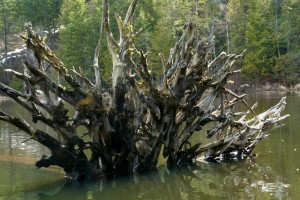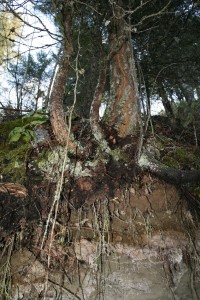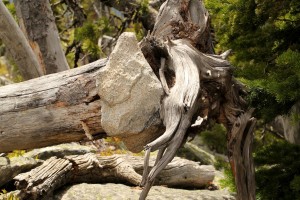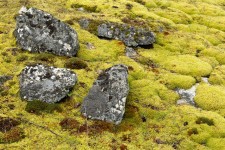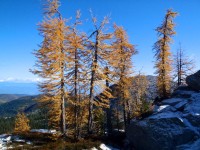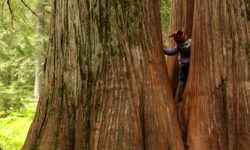Remember the incredible wind storms last summer? Tall ponderosa pines were bent over under the forty mile an hour winds. Some trees came crashing down roots and all while others snapped at weaker points along the trunk. Most trees survived–minus a few limbs– thanks to their extensive root systems.
We tend not to think about tree roots until big wind storms, tilling a new garden or pulling a stump. Without roots there wouldn’t be trees.
In addition to the obvious role of anchoring a tree in the soil, roots absorb minerals and water, conduct water and nutrients, and store food.
Unlike the trunk that grows upwards, roots tend to grow outward because most nutrients and oxygen are near the soil’s surface. Most of a tree’s roots are located within the top six to twenty-four inches of soil to maximize the absorption of water, oxygen and minerals.
The big, woody tree roots that are often exposed around the base of the tree aren’t the roots absorbing water instead they are anchoring the tree. The absorption of water, oxygen and minerals happens through the smallest roots and root hairs.
Root hairs are located just behind the root tip and are basically outgrowths of single cells. They may live for a few weeks to a few years.
When water is absorbed through the root hairs it travels through other cells to the center of the root. In the center of the root is the stele–a vascular bundle containing xylem and phloem.
The xylem transports water and minerals to the trunk and leaves while the phloem transports sugars and nutrients from photosynthesis to the growing roots.
Between the stele and the outer edge of the root (called the epidermis) is the cortex. Ever wonder how a tree can produce leaves in the spring with no leaves to start photosynthesis? Sugars and nutrients photosynthesized last summer are stored in the cortex’s cells. Come spring, the xylem transports the “food” to the buds where it is needed.
So the large tree roots do more than anchor the tree, they also store food. At one point, those large roots were small and absorbed water and nutrients. Over time they grew much like a branch becoming thicker towards the trunk and smaller away from it. Unlike branches, roots have no branching pattern. The shape of the root system is dependent on moisture, oxygen, soil texture and obstacles such as rocks and other tree roots. Whitebark pine growing on a rocky ridge with minimal soil have a completely different root system shape than a ponderosa pine growing in sandy soil.
Typically most roots occupy an area two to seven times the diameter of the tree’s crown. The root hairs greatly increase the surface area of the root system which helps in the absorption of more water and nutrients.
Many tree species increase their absorption of nutrients through mycorrhizae associations which are symbiotic relationships with fungi. The tree provides nutrition for the fungi to complete its life cycle while the fungi absorbs water and minerals through its hyphae and transfers them to the tree.
Surface area is key to obtaining nutrients and water and with mycorrhizae associations a tree’s surface area increases tremendously. For each centimeter of root, the attached hyphae can extend as much as nine feet into the surrounding soil.
More is happening beneath the surface than we tend to think. But all that root growth is appreciated when a big wind storm comes along.

